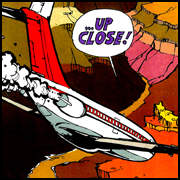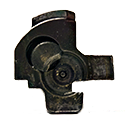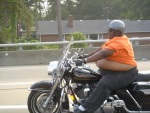|
Slavvy posted:On true dirt bikes (450's, 250f's etc) the expected use is mostly standing up, with emphasis on being able to grip and control the bike while standing, as well as the ability to move back and forth around the extremities of the bike for traction/balance. This is all correct.
|
|
|
|

|
| # ? Jun 5, 2024 00:23 |
|
Slavvy posted:These sorts of compromises are inherent in every last detail of bike design. I often talk about bikes being philosophically faulty, what I'm referring to is the mixture of compromises making no sense, for example an 'adv' with a 4 cylinder and fat 17" wheels - useless on dirt, lackluster on tarmac, only exist for marketing reasons.
|
|
|
|
I mean, once you take away the plank seat and spiky pegs, 'dual sport ergonomics' are just a normal bike from 1980. I've said it before: the UJM riding position is THE correct riding position. Sporting pretensions have permeated every model segment from the early 80's through to today, modern scramblers/ADV's are basically just the first bikes to break out of this mould because their marketing value lies elsewhere. A big adv is basically a glamorous way to own a perfectly good street bike without having your penis feel smaller when people tell you it's slow and boring. My favorite example is the multistrada: an absolutely phenomenal road bike with some vaguely off-road styling to reel in the midlife crisis crowd; they correctly identified they were building a bike for a person, not a purpose, and the results are stellar. Like yeah, the perfect street bike is a plush bouncy upright bike with office chair ergos like a cb750. But people's fixation on paper specs (largely the product of ignorance and crap skills) and visual signifiers keeps dragging things in senseless directions. The feedback loop of ignorance and marketing is in a perpetual tug of war with more enlightened thinking.
|
|
|
|
|
Holy crud, that is a really complete answer. Thanks for taking the time to write it. I bought a Kawasaki Versys-X 300. I don't really regret my purchase. First bike, sorta entry level. My idea of dirt is maybe going on a relatively flat wooded trail on property my family owns or maybe a dirt road. Seems comfortable and I've been riding it around town for a bit with no major complaints other than the gears seem short. I think you talked me out of eventually upgrading to a larger similarly styled bike. SSH IT ZOMBIE fucked around with this message at 03:52 on May 1, 2021 |
|
|
SSH IT ZOMBIE posted:Holy crud, that is a really complete answer. Thanks for taking the time to write it. I mean, it depends on what you want but you're ages and ages from 'needing' to 'upgrade' (I use quotes because those are misleading terms which imply a progression that doesn't exist). Basically if you find that you never do more than gravel roads, you either end up on a normal bike like an SV and go slower, or a motard, depending on what kind of wheee you prefer. If you find yourself doing more and more off-road stuff, get an actual enduro or a dedicated dirt bike. You can see how some bikes, like the DRZ, can do both, so they're recommend as a catch-all that everyone will get something out of. Bikes like the Vstrom 650 are pretty much just a bigger version of what you have, but their dirt capacity is less purely on the basis of being bigger and heavier but still having basic road bike suspension etc. Imo these aren't worth buying if you actually want to go off-road, they make excellent street bikes though. Some people on this forum run full size ADV's and use them for actual dirt duty. They have arrived at that compromise because it suits them, they've all got one of the few models out there that can actually do what it says on the box, and they'll all tell you an actual dirt bike is much better for the job; a good big adv is like a dirt bike with the trailer and tow vehicle built in, but you have to carry those with you on every trail.
|
|
|
|
|
I'm worried about the bike basically having no passing headspace if and when I take it on the thruway, where the speed limit is 65mph, but everyone does 70-75. It can go faster but not easily. I'm reading stories of people replacing gears to give the bike a lower top speed but better pickup. I'm not going to be doing that for a while. I hear highway driving is actually safer but I need to be able to manage everything happening at speed. I'm working on my skills in the neighborhood and gaining comfort going on coffee runs. I think I am going to be 95% on normal roads.
|
|
|
|
I've never worked on a versys 300 but if it's anything like the ninja 300 (it is), making the gearing shorter is a false economy. Yes it'll feel sprightlier in first gear, but you'll end up with a much narrower power band that makes the bike feel slower at speed. Part of the problem is your learner brain making you constantly shut the throttle every time a butterfly jumps out, which destroys your momentum and makes you have to steam back up to speed. If you can maintain momentum that bike will pass cars just fine, you just have to start further back and plan poo poo out instead of whacking it open when the whim strikes you. All of this is an integral part of being a not-poo poo rider, overcoming these handicaps is what learnering is all about.
|
|
|
|
|
do you think "short gears" is just a figment of your vestigial car brain? most motorcycles can rev really high. no, higher than that. if you think that's it, try hanging on to the gears for longer. one day, I was like, "oh I can get to 50mph in first," as the cars at the stoplight got really tiny in my mirrors.
|
|
|
|
It probably does have short gears. My bike is a 300 and first tops out around 25mph (10.5k rpm), second at ~40, and so on. Bikes should be geared as short as possible IMO, except maybe touring bikes.
|
|
|
|
I am trying to break the engine in, the manual says keep it under 4k rpm. That said, it also has general shifting speed recommendations and they have you in sixth around 30mph.
|
|
|
|
Toe Rag posted:It probably does have short gears. My bike is a 300 and first tops out around 25mph (10.5k rpm), second at ~40, and so on. Bikes should be geared as short as possible IMO, except maybe touring bikes. car brain makes you think 6k is going to throw rods we all must shed the steel cocoon in our minds to emerge as the beautiful monarchs of the open roads
|
|
|
|
Learning to just rev it "no, higher" was the most important thing for me. I still cruise really low because I am an eco driver.
|
|
|
|
I already had my first what the gently caress moment. So, from a single turning lane into a double lane road you are supposed to legally turn into the inner most lane. A truck behind me went into the outer lane. I'm not like going to cut him off on my tiny rear end bike so I missed my next right turn, made some space by speeding up, and had to turn around in a parking lot. Should I say gently caress it and turn into the outer lane? Just let it go? Turning into the outer lane has risks if people decide to do right on red and assume I am turning into the inner lane as I should be.
|
|
|
|
If the road I'm turning onto is clear, I'll turn into whichever lane is best for my upcoming route, legality be damned. If you're concerned about following the rules, finish your left turn into the inside lane then immediately signal and shoulder check and change lanes to the outside lane, before the car behind you has even had the time to finish their own left turn. It sounds like either the guy behind you was being extremely aggressive (in which case you were right not to cut in front of him), or you spent enough time in the inside lane that he thought that's the lane you wanted and thus thought he was OK to pull up past you. As for right on red people ahead of you, you should be assessing them as a threat regardless of your own lane choice. They could just as easily pull out into either lane, so if you see them pull out give yourself enough time and space to avoid them while they're turning.
|
|
|
Toe Rag posted:It probably does have short gears. My bike is a 300 and first tops out around 25mph (10.5k rpm), second at ~40, and so on. Bikes should be geared as short as possible IMO, except maybe touring bikes. No, wrong. Power spread is what makes bikes fast, small bikes have short gearing out of necessity but it's a crap thing having to downshift four times into every corner and upshift twice in the middle because it runs out of revs. Literally just went through this with my mate's cb1000; going +1/-2 on the sprockets has made it twice as fast, the gearing was ludicrously close together for a literbike, like they wanted to build the fastest bike in the world to 100km/h, you couldn't use any of the engine's torque and there was never a right gear for any given corner, you were always running out of revs. SSH IT ZOMBIE posted:I am trying to break the engine in, the manual says keep it under 4k rpm. Ooooh lmao you have no clue how fast your bike is, prepare for plaid after you've done the first oil change. Once it's broken in, as has been said: it isn't a car, you can't hurt it with revs, anything between idle and the redline is cool and good. It's better for the engine to be in it's sweet spot than lugging around at low rpm where it's super inefficient and has no oil pressure.
|
|
|
|
|
Finally got everything legal with the bike, so I took it out this morning to a school parking lot in my neighborhood and practiced smooth starts, emergency stops, weaves etc all the basic msf things. Rode around the neighborhood and down dirt alleys to get a feel of how the ABS feels when you lock up the brakes. Things I'm having a hard time with are I need to be more revvy with the throttle. I think I have the car clutch mindset where I'm trying to be as smooth as possible between the clutch and throttle, but I know you can slip motorcycle clutches all day long. As a result I stalled a bunch of times. Another thing that happens during emergency stops is I'm giving the bike throttle unintentionally. I think this is because I'm braking with two fingers and maybe my thumb is just rolling thr throttle under hand pressure. Going to practice some more later tonight when it cools off.
|
|
|
|
Haha. I did my BRC on a Honda Grom. I used to stall all the time. That thing trained that out of me really quick. I was kinda dumping the clutch without realizing it.
|
|
|
|
Slavvy posted:a good big adv is like a dirt bike with the trailer and tow vehicle built in, but you have to carry those with you on every trail. lol this is an excellent way to put it, thank you
|
|
|
|
Russian Bear posted:Finally got everything legal with the bike, so I took it out this morning to a school parking lot in my neighborhood and practiced smooth starts, emergency stops, weaves etc all the basic msf things. Rode around the neighborhood and down dirt alleys to get a feel of how the ABS feels when you lock up the brakes. For a small bike, you need to rev it around 3000-5000rpm when pulling away briskly. Varies per bike, it can be even more but it is rarely less than 3000. Take an average car's usable rev range, multiply it by 2, ride the bike approximately in that rev range. Emergency braking - i wouldn't use just two fingers for a full emergency stop. First do the standard thing (use your whole hand), and once you master that, go see if there are other ways that suit you better than the conventional way. Learning to give it gas while braking is also a useful skill btw, but that's definitely a higher skill level and you don't have to be concerned about that yet. Braking and revving at the same time is useful for rev matching/blipping while down shifting for a traffic light. LimaBiker fucked around with this message at 21:58 on May 1, 2021 |
|
|
|
Russian Bear posted:Finally got everything legal with the bike, so I took it out this morning to a school parking lot in my neighborhood and practiced smooth starts, emergency stops, weaves etc all the basic msf things. Rode around the neighborhood and down dirt alleys to get a feel of how the ABS feels when you lock up the brakes. 1. Get earplugs. 2. When wearing earplugs, you'll not be as worried about how loud the bike is, which will make you more likely to rev it more. 3. Rev it more. Give it lots of revs. From a stopped position, with enough revs, provided you don't whack open the clutch, i.e. you open it at slow or medium pace, you should not ever stall. 4. a. If, during emergency stops, you pull in the clutch at the same time, it won't matter if you're accidentally giving a bit of throttle. Pulling in the clutch will also stop the bike from stalling if you emergency brake to a dead halt on the street. This is not that important though, seeing as emergency stopping is primarily about stopping safely; who gives a poo poo if you have to start it up again and whack it into first? 4. b. Your front brake lever may need to be rotated to be "in line" with where your hands fingers naturally open to, to allow you to grab it instinctively and not gently caress with the throttle overmuch (or at all) when you do. A similar rotational adjustment may be needed for the clutch if you feel it's also not in line with where your fingers naturally are when your hand is open, palm down. 5. Just get out and ride in quiet neighbourhoods/countryside a lot, you'll improve with practice. For reference, I did about 2000 miles on my 125 before I passed my A license test in the UK (I know you are now in America, but it's good to practice on something small, which you are doing).
|
|
|
|
Slavvy posted:No, wrong. Power spread is what makes bikes fast, small bikes have short gearing out of necessity but it's a crap thing having to downshift four times into every corner and upshift twice in the middle because it runs out of revs. Literally just went through this with my mate's cb1000; going +1/-2 on the sprockets has made it twice as fast, the gearing was ludicrously close together for a literbike, like they wanted to build the fastest bike in the world to 100km/h, you couldn't use any of the engine's torque and there was never a right gear for any given corner, you were always running out of revs. By short as possible, I meant that if a bike can only go 160 then its top gear should be good ~170. Maybe this is how most bikes are already! If the gears are so short it hamstrings the bike then thatís a bad thing. I was thinking in the context of cars which are usually geared super tall for fuel economy.
|
|
|
Toe Rag posted:By short as possible, I meant that if a bike can only go 160 then its top gear should be good ~170. Maybe this is how most bikes are already! If the gears are so short it hamstrings the bike then that’s a bad thing. I was thinking in the context of cars which are usually geared super tall for fuel economy. That's how small bikes generally are yeah, on big bikes usually fifth and sixth are 'too long' but unless you're on a race track that's a good thing, it keeps rpm low and economy decent, you can just shift down once for passing or whatever. These rules of thumb only apply to normal street bikes, cruisers and ADV's do their own weird compromise gearing.
|
|
|
|
|
Steakandchips posted:1. Get earplugs. 4a) General wisdom around my parts is, that you should always use the clutch, because during high stress braking you can easily whack on the gas which increases stopping distance if the brakes have to fight the motor. Having done emergency stopping drills just yesterday at 100kph/60mph I can confirm that a lot of people do something wrong every other time. Forgetting the clutch is one of those, but you should really practice everything (clutch, front and back brakes as well as locked arms) in order to have the highest chance of getting the shortest brake distance.
|
|
|
|
SSH IT ZOMBIE posted:I am trying to break the engine in, the manual says keep it under 4k rpm. You shouldn't bother with the under 4k limit, it will hamstring the bike and make you learn wrong as a joke. By contrast, it is a good idea to let the bike warm up before taking off. I also am a new first-bike Versys 300X owner. 2019 model, RRP $AUD 6600, + "pre delivery" 495, - dealer discount (negotiated) 694, + delivery Sydney to Canberra 300 = 6700 before on roads Currently at 2600km total, 85% on road. I wholly agree with Slavvy, to me it seems his comments come from a place of deep familiarity with bikes in general and he accurately describes this bike totally. I could only add that the gearing doesn't feel nearly so Also avoid being too throttle-shy taking off at lights. Hopefully the MSF has drilled it in that you can comfortably rev to 3k while stationary and the slipper clutch will smoothly and confidently get you rolling into first. Ryan was exaggerating about the motoGP noises in the carpark - its fine, no-one cares. If you wanted to change the sproket size, I think that will mean you sacrifice flexibility during very technical low speed dirt stuff which is the most difficult riding. antipope fucked around with this message at 03:56 on May 2, 2021 |
|
|
|
I'm of the opinion that chassis geometry is designed with the engine braking effect on mind, the bike isn't the same shape with the clutch pulled as the abscence of back-torque will make it dive more and unload the rear tyre more than usual. Ideally you really want to be in gear.
|
|
|
|
|
Steakandchips posted:4. a. If, during emergency stops, you pull in the clutch at the same time, it won't matter if you're accidentally giving a bit of throttle. Pulling in the clutch will also stop the bike from stalling if you emergency brake to a dead halt on the street. This is not that important though, seeing as emergency stopping is primarily about stopping safely; who gives a poo poo if you have to start it up again and whack it into first? haha, the only point I lost in the MSF test was for stalling during the E-stop.
|
|
|
|
Anyone wanna share some dirt road / trail tips? I've done a fair bit of maintained dirt roads in the DR and I'm comfortable at 60-70km/h on the road tires. As soon as I'm off those and into something rutted, I feel like I'm starting to outride my skill at about 50km/h max, more like 30-40 if it's got more than gentle turns. On the postie I'll happily pin it in super sketchy "roads" and fly along at... yeah ok still only 30 or so. But I feel like I'm going hard on it while babying the DR on the same stuff. But if I try to go similarly hard on the DR (and thus much faster) it just kind floats around and feels real sketchy. I can handle the back sliding around but it feels to my beginner brain that the front's gonna wash out.
|
|
|
|
my tip is to only go ham if you've got cell service lol cause any crash at like 40mph and up in the dirt is not fun that being said you may wanna take a look at your tire pressures. I always drop them significantly (~23psi front ~28psi rear vs 36 / 40 on road) as soon as I ditch the pavement and then just refill once I get back on if I am feeling not lazy. this is on shinko 805s too which are not good offroad tires, but are pretty decent on road and pretty decent off road while lasting ~5000mi
|
|
|
|
Tires. Air pressure. Road conditions. They're crucial to riding off pavement. Having good grippy semi lugged tires help as does airing down. My dirt bike suggests 15psi for my tires but I usually run 12-13. There's a huge difference in how it behaves between the two. First, try not to use your front brake. Assuming you're mostly talking about dirt roads, you're using speed as a measure of success but even on my dirt bike in not ripping through dirt roads with that much speed very often unless it's really straight and the surface is smooth. Your stopping distance is significantly increased and grip reduced plus you're likely to encounter wildlife or other vehicles/bikes often with limited sightlines. A lot of dirt bikers will tell you to power out of a lovely situation, specifically a corner. It seems counter intuitive but it can get your bike upright and smooth out a corner. A lot of times when you get to something that feels like it's about to go bad, we hesitate or try to slow down which often exacerbates the problem and you feel the right of the bike want to fall. This is how a lot of people drop their bikes in corners because they panic and stop rather than continue on. Riding dirt isn't like riding pavement. You're not carving corners quite the same. You're almost expecting the rear end end to slide out but your front constantly feels like it's going to go at any time. The surface can change by the foot. Wash board, river rocks (the worst) or hard clay with marbles on top, it all feels different and have its own difficulties. Turns can feel downright sketchy at times. I've had my fair share of unintended flat tracking with a foot down and my bike sliding out. Just ride more. It's tricky but you'll eventually start to feel it. It's hard transitioning from pavement where you can predict the surface and trust the grip of your front tires a bit more. There's an orv place by me that they covered most of the roads in 2-3" smooth river rock and that shits the worst. Both tires will feel loose and washy, kind of like riding through deep sand or on wet metal grates. I'll ride the technical enduro trails with much less stress then the dumb connector roads. Verman fucked around with this message at 05:40 on May 3, 2021 |
|
|
|
From a setup angle try lowering your rear preload a chunk, it'll make it slow and understeery on the road but it'll help with losing the front on the loose stuff. Sitting/standing as far back as possible helps, as does the throttle - my new to dirt experience after riding pavement for years was that the front is reliable for steering and almost nothing else, the rear brake is the good brake, the clutch is an active participant, the throttle is your friend keep the bike as rear-laden as you can.
|
|
|
|
|
I did it   All in all about 4-5 hours of riding on backroads + a dash of highway. The amount of "Oh poo poo I remember that" the CL350 gets is wild - people straight up walking by Ducatis, BMWs, and Aprilas to take a look at it at a breakfast meet today. However, I think the headlight is a standard bulb which isn't quite so great. Should I just spring for a LED swap from Common Motor or just grab a halogen? In addition, are there any suggestions for crosswinds - I mostly just kept reminding myself to relax and the bike will do what it needs to.
|
|
|
|
Elector_Nerdlingen posted:Anyone wanna share some dirt road / trail tips? Verman and Slavvyís tips are good, but also drill it into your head to keep your weight on your feet as much as possible, even when your butt is on the seat. Thatís good for road too, but the effect that has on dirt handling is more pronounced. You can feel what the bike is doing better, and in lower speed technical stuff, exert a good bit of control. Weight on the pegs, legs gripping tank/seat, loose arms. I think one reason the postie feels better is that itís lighter, so itís just transmitting all road feel to you. Whereas the DR eats up a lot of vibration through its mass and spongy suspension. Speculation, but I notice the same thing you describe between my old DR350 and the 650, and making those posture changes helped.
|
|
|
|
SSH IT ZOMBIE posted:Just let it go This is the answer. That does not mean it's easy but it is dumb to fight with a person driving a six thousand pound death machine. You will be injured or killed. Just assume nobody sees you and let it go, whatever it might be. No matter how wrong or mad you are, let it go and just keep riding. Elector_Nerdlingen posted:Anyone wanna share some dirt road / trail tips? If you pin it on the DR you'll be going over 100 so that makes sense? Here are a couple of thoughts I have on dirt. Don't outride your skills in the dirt. You're going to fall anyway, but that will make you fall faster and it will hurt more. 1. Watch the beginner crosstraining enduro videos and then go practice that stuff. It's both fun and you'll learn and get better at riding dirt by practicing it. 2. Stand up on the pegs. If you're sitting down, scoot way forward. Further forward than that. This lets the rear dance around more. But instead, stand up. Yes, this is more tiring. 3. Look up. Your bike will almost certainly go over almost anything you throw at it. It will certainly go over and through things that you think it won't. But if you look down you will go down. So look up and look where you want to go. 4. Practice braking. Traction changes off road and you'll get used to that as you keep riding but until reading that becomes second nature it's worth just practicing braking every so often to see what kind of traction you're working with. right arm posted:my tip is to only go ham if you've got cell service lol cause any crash at like 40mph and up in the dirt is not fun DR has tubes so you can definitely run 10-12 if you bring a pump. I'd probably start with 15 fwiw, as that'll be nice and squishy but still firm enough that it doesn't feel too different in corners. Verman posted:Tires. Air pressure. Road conditions. They're crucial to riding off pavement. Having good grippy semi lugged tires help as does airing down. My dirt bike suggests 15psi for my tires but I usually run 12-13. There's a huge difference in how it behaves between the two. When in doubt, throttle out. The point about speed is quite good though. Just go slower until you feel more comfortable. Then go slower and focus on your technique. Also seconding gently caress that kind of rock. It's like sand that hurts to fall on.
|
|
|
|
outriding your lizard brain rarely ends up good https://streamable.com/4odud
|
|
|
|
Razzled posted:outriding your lizard brain rarely ends up good Lol. I kept waiting for a deer to jump out or an oncoming vehicle, not just riding off the corner.
|
|
|
|
Razzled posted:outriding your lizard brain rarely ends up good I liked the woo-hoo.
|
|
|
|
Razzled posted:outriding your lizard brain rarely ends up good That looked considerably more enjoyable than the on-street equivalent
|
|
|
|
T-Shaped posted:I did it Hell yeah brother. I get the exact same response from my CL. Nobody knows what a Hawk is (I think I've gotten exactly one dude who was like "nice, those are great bikes") but everywhere I take the CL I'm swarmed with old dudes telling me how they rode one to high school every day until they crashed hahaha had to layer dan you know and then i was just scared of it so i sold it but i kinda was thinking of picking one up again now but the ol' wife won't let me hahaha Yes, the stock bulb is a 25/35 watt (H/L) incandescent and it's about as bright as a candle. Your options for replacement are: - replace the entire headlamp and bucket with some modern equivalent (lots of options on dime city cycles etc) - replace only the reflector with a 5-3/4" H4-compatible reflector and an H4 bulb https://www.ebay.com/itm/232524966750?hash=item3623916b5e:g:KuAAAOSwjANeWvF8 (this says 6v but that's just the bulb, throw it away and install the right one) - replace only the reflector with a 5-3/4" sealed LED unit https://www.amazon.com/Funlove-Headlight-Harley-Davidson-Motorcycles/dp/B06ZYJHT3K/ (note that this is deeper and heavier than a regular reflector and will require some creativity with the wiring inside) No matter what you choose, you need to stick around 35w max draw because the CL350's electrical system can't handle a proper 55w automotive halogen bulb. In fact, the stock alternator can only handle the 35w high beam if you're revved up -- old bikes were not designed to run the lamps continuously like new ones are. Halogen bulbs also put out a lot more heat than incandescent ones and I would be kinda concerned about the wiring and the plastic the stock bucket is made from. I went with option 2, keeping the stock bucket and putting in an H4 reflector, and also installed a generic H4 LED bulb. The beam pattern probably is not legal any more but it's as bright as a 55w halogen and stays cold and only draws about 25w, which lets you run it continuously (as you should). I also got a rewound alternator stator for peace of mind but that strictly shouldn't be necessary if you just go LED. e: yes, you have the right idea with crosswinds. relax and recognize that the bike doesn't want to fall over; be light on the controls and let it do its thing. if there's a significant wind you will be leaned into it in order to track a straight line. that feels a little weird at first but it's normal. Sagebrush fucked around with this message at 23:58 on May 3, 2021 |
|
|
|
Sagebrush posted:Hell yeah brother. I get the exact same response from my CL. Nobody knows what a Hawk is (I think I've gotten exactly one dude who was like "nice, those are great bikes") but everywhere I take the CL I'm swarmed with old dudes telling me how they rode one to high school every day until they crashed hahaha had to layer dan you know and then i was just scared of it so i sold it but i kinda was thinking of picking one up again now but the ol' wife won't let me hahaha Solid. I put in an order for a LED bucket + bulb package from Common Motor, along with a LED swap for the instrument panels/turn signals/etc. Might as well do it all. I will say, it's not my fav on the highway so far - it likes to go about 60 before the throttle starts giving diminishing returns (around 6k RPM in top gear, but I'm still getting used to wind/etc, I know I could rev higher), but the parkways and pure chill riding have been great. I know I have the carb running a dash rich, so I'll revisit it soon. I know it's not a perfect starter bike, but honestly doing bits of work on it as I go has been keeping me sane and reteaching me some of my old automotive skills again. If anything, even younger sportbike riders still tossed me a wave as I went up Blue Mountain, and it makes my wife happy that she'll get to give the bike a 50th birthday next year.
|
|
|
|

|
| # ? Jun 5, 2024 00:23 |
|
Yeah it isn't a highway bike. You could go down two teeth on the rear sprocket if you're okay trading acceleration and low-speed putterability for lower RPMs at speed; the CL came with +2 stock versus the road-oriented CB. But I wouldn't bother because the main problem is that the suspension and brakes are not suited to those speeds. Your front brake is maybe better than the standard drum, maybe not (those early discs weren't great) but the suspension is still a pogo stick and the frame is a swingset and your tires are 3 inches wide. It just isn't fun at modern freeway speeds. I find that mine is happiest between 0 mph, where it can putter along in gear at a walking pace with the engine idling, and 55 mph, which is about where the wind starts to pick up and you're on the descending side of the power band. Perfect at 40 around town. You'll only get like 100 miles, maybe 110, from the gas tank anyway. Nearly every big freeway still has the old highway paralleling it somewhere within a couple of miles. Go and find it instead, and you'll have a way better time on those slightly more meandering two-lanes than the interstate hell world. A bit rich is better than a bit lean, especially on an air-cooled bike like this.
|
|
|

































